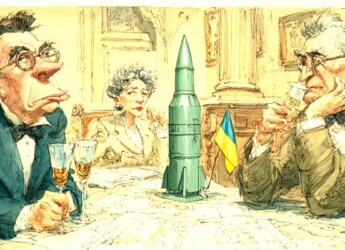Editor’s Note: This article provides a concise examination of key developments in the Russo-Ukrainian War over December 20-21, 2024, with a special focus on Ukraine’s groundbreaking use of robotic systems in combat and its implications for modern battlefield dynamics. The narrative explores the transformative role of technological innovation in reshaping warfare, alongside updates on escalating territorial skirmishes and strategic maneuvers by both sides.
Additionally, a short addendum connects these events to broader considerations for cybersecurity, information governance, and eDiscovery professionals, highlighting how military innovations and tactics have far-reaching implications for the security, management, and legal handling of digital information in civilian sectors.
For those seeking to grasp the full scope of this evolving landscape, the complete updates from the Institute for the Study of War serve as an invaluable resource.
Cutting-Edge Combat: How Robotics Are Shaping Ukraine’s War Effort
Information - 92%
Insight - 93%
Relevance - 92%
Objectivity - 94%
Authority - 95%
93%
Excellent
A short percentage-based assessment of the qualitative benefit expressed as a percentage of positive reception of the recent article from ComplexDiscovery OÜ titled, "Cutting-Edge Combat: How Robotics Are Shaping Ukraine’s War Effort."
Background Note: ComplexDiscovery’s staff offers distinctive perspectives on the Russo-Ukrainian war and Middle Eastern conflicts, informed by military experience on the West German, East German, and Czechoslovakian border during the Cold War and in Sinai as part of Camp David Accord compliance activities. This firsthand regional knowledge has been further enhanced by recent staff travels to Eastern European countries, including Estonia, Finland, Latvia, Lithuania, and Poland. These visits have provided up-to-date, on-the-ground insights into the current geopolitical climate in regions directly impacted by the ongoing conflict.
Combined with cybersecurity, information governance, and eDiscovery proficiency, this multifaceted experience enables comprehensive analysis of these conflicts, including the critical impact of cyber warfare, disinformation, and digital forensics on modern military engagements. This unique background positions ComplexDiscovery to provide valuable insights for conflict-related investigations and litigation, where understanding the interplay of technology, data, and geopolitical factors is crucial.
Russo-Ukrainian Conflict Update*
Cutting-Edge Combat: How Robotics Are Shaping Ukraine’s War Effort
ComplexDiscovery Staff
The Russo-Ukrainian War has become a proving ground for 21st-century military innovation, blending age-old tactics with cutting-edge technology. This duality was particularly evident in late December 2024, as both sides escalated their efforts to claim strategic advantages. Amid the destruction wrought by Russia’s missile strikes and territorial skirmishes, a groundbreaking Ukrainian operation using robotic systems heralded a new chapter in modern warfare. This bold application of autonomous technology not only disrupted conventional battlefield expectations but also signaled a paradigm shift in the way combat operations are conducted. The implications extend beyond this conflict, hinting at the transformative potential of robotics in reshaping battlefield dynamics worldwide.
The Dawn of Fully Robotic Combat
On December 20, Ukrainian forces achieved a historic milestone in military operations: a successful assault conducted entirely by unmanned systems. Near the town of Lyptsi in Kharkiv Oblast, dozens of unmanned ground vehicles (UGVs) equipped with machine guns executed an attack, supported by reconnaissance and first-person view (FPV) drones. This autonomous assault targeted entrenched Russian positions, neutralizing them with precision while sparing Ukrainian personnel from exposure to direct combat.
This robotic assault not only achieved a tactical victory but also demonstrated the potential of robotics to redefine battlefield engagements. The UGVs were capable of performing tasks traditionally handled by infantry, such as clearing mines, laying obstacles, and delivering direct fire. Supported by drones that enhanced situational awareness and targeting, the systems operated cohesively, highlighting their potential to conduct operations autonomously in increasingly complex scenarios.
Ukraine’s successful deployment of this technology reflects months of strategic innovation. Ukrainian engineers and military planners have prioritized integrating advanced robotics into frontline operations, a necessity driven by the war’s attritional nature and Ukraine’s limited manpower. Beyond this immediate tactical success, the operation underscores a shift in military doctrine, moving from the concept of robots as support tools to robots as independent, frontline combatants.
Changing Battlefield Dynamics
The integration of robotic systems is altering the dynamics of modern warfare. Historically, revolutions in military technology—from the tank to the drone—have fundamentally reshaped how conflicts are fought. Ukraine’s robotic operation represents the next evolution, where machines are not just tools but active participants in shaping the battlefield.
For Ukraine, this capability offers significant strategic advantages. It reduces reliance on human soldiers in high-risk engagements and leverages technological innovation to counter Russia’s numerical superiority. The ability of these systems to perform multi-faceted tasks autonomously, from neutralizing enemy positions to clearing obstacles, expands the scope of operational possibilities. This shift forces adversaries to adapt rapidly, creating a more unpredictable and dynamic battlefield environment.
Conversely, the use of robotics places pressure on Russia’s traditionally attritional approach to warfare. Reliant on massed forces and conventional tactics, the Kremlin now faces a technologically adaptive adversary. While Russia has demonstrated some capability in the field of drones and autonomous systems, its progress lags significantly behind Ukraine’s innovative application of such technologies.
The Broader Technological Context
This operation forms part of Ukraine’s broader strategy to integrate advanced technologies across its military operations. Beyond UGVs, Ukraine has recently unveiled a fiber-optic-controlled drone designed to be more resistant to electronic warfare. This advancement enhances operational reliability in environments saturated with Russian electronic warfare capabilities, such as the heavily contested eastern and southern theaters.
Moreover, Ukraine’s emphasis on domestic drone production has reduced its reliance on foreign-supplied technology. The recent development of drones made entirely from locally sourced components ensures greater resilience amid uncertainties in international military support. These innovations underscore Ukraine’s strategic foresight, showcasing a commitment to sustaining its technological edge while mitigating supply chain vulnerabilities.
Escalations in the Broader Conflict
While technological innovation captured attention, the broader conflict remained marked by intense violence and territorial contests. On December 20, Kyiv endured a missile barrage that, despite Ukrainian air defenses intercepting all missiles, caused damage to civilian infrastructure and diplomatic missions due to debris. The Russian missile campaign reflects its continued effort to strain Ukraine’s resources and morale while keeping its capital under constant threat.
In the contested Kursk Oblast, Russian forces leveraged elite airborne units to make marginal territorial gains, only to face effective Ukrainian counterattacks. Allegations of North Korean military personnel operating under Russian command add a layer of complexity to the conflict, highlighting the Kremlin’s reliance on unconventional manpower sources. Meanwhile, in the eastern Donetsk Oblast, fighting near Toretsk and Vuhledar underscored the grinding nature of the war, where gains were often incremental and came at high costs.
In a bold escalation, Ukrainian forces extended their operational reach into Russia’s Republic of Tatarstan, launching drone strikes on industrial and residential areas in Kazan. This cross-border operation highlighted Ukraine’s willingness to challenge Russia’s security far from the frontlines, underscoring the conflict’s expanding geographical scope.
Challenges and Opportunities in Robotic Warfare
While the success of Ukraine’s robotic assault is a landmark achievement, it is not without challenges. Scaling such operations requires significant resources, advanced technical expertise, and time—all of which are limited in an ongoing conflict. Moreover, the increasing reliance on autonomous systems introduces logistical and ethical considerations, including questions of cost, operational reliability, and the extent of human oversight.
For Russia, the implications are severe. Facing an opponent that is increasingly adept at integrating advanced technology, the Kremlin must reassess its reliance on traditional massed-force tactics. While Russia has made strides in drone production, its delayed adoption of innovative systems has left it at a technological disadvantage, which could further erode its operational effectiveness over time.
Innovation, Manpower, and Firepower
The robotic assault near Lyptsi marks more than a tactical success; it represents a watershed moment in modern warfare. As Ukraine pushes the boundaries of autonomous systems, the battlefield is transformed into a dynamic and unpredictable theater where innovation becomes as vital as manpower or firepower.
This achievement ties back to the broader narrative of the war: a smaller, resource-constrained nation leveraging resilience and ingenuity to challenge a larger, conventionally superior adversary. As the Russo-Ukrainian War progresses, such milestones not only shape the immediate conflict but also redefine the global understanding of how wars will be fought. The enduring spirit of adaptation and creativity on display serves as a testament to the power of innovation in overcoming even the most formidable challenges, ensuring that the lessons of this war will resonate far beyond its frontlines.
Addendum: Implications for Cybersecurity, Information Governance, and eDiscovery Professionals
The developments in the Russo-Ukrainian War, particularly Ukraine’s use of robotic systems and advancements in drone technology, carry significant implications for cybersecurity, information governance, and eDiscovery professionals. These military innovations highlight the intersection of conflict and digital technology, offering valuable lessons for civilian industries grappling with similar challenges.
The deployment of autonomous systems in combat underscores the need for robust cybersecurity measures. As robotic platforms and drones take on more prominent roles in sensitive operations, they become potential targets for cyberattacks. The conflict illustrates the critical importance of securing communication networks, ensuring the integrity of autonomous systems, and developing resilience against interference. Ukraine’s use of fiber-optic-controlled drones, designed to be more resistant to electronic warfare, demonstrates the necessity of advancing communication technologies to mitigate vulnerabilities—lessons directly applicable to civilian sectors where secure, reliable systems are vital.
The increasing reliance on robotics and autonomous systems also generates immense volumes of operational data, from real-time video feeds to machine-generated logs. Managing, securing, and analyzing such information is a growing challenge that mirrors the complexities faced by organizations in other industries. Effective data governance frameworks are essential for ensuring data accessibility, regulatory compliance, and long-term usability. Professionals in information governance can draw parallels between the wartime handling of operational data and the challenges of managing digital information across jurisdictions and applications.
Furthermore, the war highlights the evolving nature of digital evidence. From geolocated battlefield footage to telemetry data, digital artifacts are playing a critical role in documenting activities and informing strategies. For eDiscovery professionals, the methodologies used to authenticate and analyze this evidence align closely with the processes required in legal and investigative contexts. The proliferation of machine-generated datasets and the use of advanced technologies in operations demand a forward-thinking approach to eDiscovery, anticipating new types of discoverable information and developing tools to manage them effectively.
As the Russo-Ukrainian War continues to shape the role of technology in conflict, it also provides valuable insights into the future of cybersecurity, information governance, and eDiscovery. The integration of autonomous systems and the challenges of managing complex digital information environments underscore the importance of adaptability and innovation in these fields. Understanding these dynamics equips professionals to navigate an increasingly digital and interconnected world, where the lessons of the battlefield often find resonance in civilian applications.
News Sources
As a leading source for cybersecurity, information governance, and legal discovery insights, including international investigations and litigation, ComplexDiscovery OÜ recognizes the importance of awareness regarding alleged and documented criminal acts, particularly in the context of the Russia-Ukraine conflict. While we, following the lead of the Institute for the Study of War (ISW), do not provide detailed coverage of war crimes in our primary reports, we encourage professionals within the eDiscovery ecosystem to stay informed about these activities. This awareness is crucial for understanding potential future legal actions and responsibilities.
Detailed Reporting with Maps for December 20-21, 2024, from the ISW – Mouseover to Scroll
Russo-Ukrainian Conflict Update - December 20-21, 2024Review the Detailed Reporting and Maps PDF
About the Institute for the Study of War Research Methodology
ISW’s research methodology relies on both primary and secondary sources, enabling researchers to develop a comprehensive understanding of the situation on the ground. In order to analyze military and political developments in any given area, ISW’s research analysts must wholly understand the systems of enemy and friendly forces. They must also understand the population demographics, physical terrain, politics, and history of that area. This lays the analytical foundation for understanding the reasons for particular developments and fulfilling their assigned research objectives. ISW analysts also spend time in places like Iraq, Afghanistan, and elsewhere in order to gain a better understanding of the security and political situation and to evaluate the implementation of current strategies and policies. Our researchers compile data and analyze trends, producing a granular analysis of developments in areas of research, producing an accurate, high-resolution, timely, and thorough picture of the situation. ISW’s research methodology guarantees its success and commitment to improving the nation’s ability to execute military operations, achieve strategic objectives, and respond to emerging problems that may require the use of American military power.
About the Institute for the Study of War
The Institute for the Study of War advances an informed understanding of military affairs through reliable research, trusted analysis, and innovative education. They are committed to improving the nation’s ability to execute military operations and respond to emerging threats in order to achieve U.S. strategic objectives. ISW is a non-partisan, non-profit, public policy research organization.
Learn more, get involved, and contribute today.
Additional Reading
- From Dissent to OSINT? Understanding, Influencing, and Protecting Roles, Reputation, and Revenue
- [Annual Update] International Cyber Law in Practice: Interactive Toolkit
- Data Embassies: Sovereignty, Security, and Continuity for Nation-States
Assisted by GAI and LLM Technologies
* Sourced and shared with direct express permission from the Institute for the Study of War (ISW).
Source: ComplexDiscovery OÜ


























